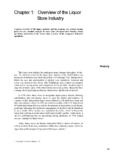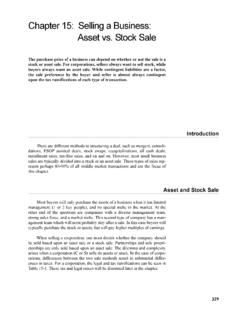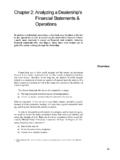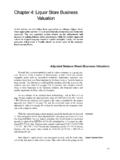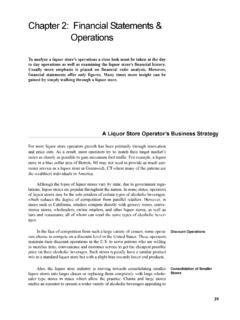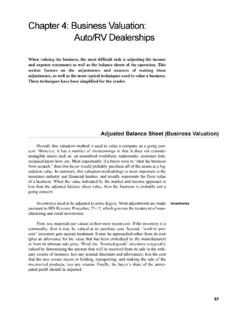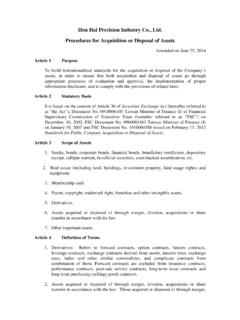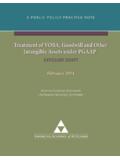Transcription of Chapter 4: Business Valuation (Adjusted Book Value …
1 65 Chapter 4: Business Valuation (Adjusted book Value or Cost Approach)In adjusting the balance sheet, the most difficult task is to mark tomarket (substitute market values for book values) the assets andliabilities. This section focuses on the adjustments and nuances of makingthese of the shortcomings of the historical-cost balance sheet is that it isunlikely to reflect intangible assets. This approach is most appropriate for thevaluation of a holding company, particularly one in which the current returnsavailable to shareholders do not adequately reflect the fair market Value of thebusiness in its entirety. It is appropriate to look at the underlying assets of thefirm to determine what investments might be justified over the longer adjusted-balance-sheet (or cost) approach to Value involves a determi-nation of the going-concern fair market Value of all assets and liabilities of abusiness.
2 After calculating the Value of the Business via an income approach,many buyers will only pay for the fair market Value of the assets less liabilities,plus some intangible Value ( from zero to two times annual pretax income).When a Business is more of a commodity Business with low margins, then thisapproach is most relevant. Visually, the determination of a going concern can beseen in Figure 4-1 on page 66. Adjusted means that the book Value of assets and liabilities are adjustedto their fair market values, or marked to market. The difference between theadjusted assets less the adjusted liabilities is the assumed market Value of thestockholder problem with this approach is that much of a Business worth may bederived from its cash flows and working capital and not from fixed or intangibleassets. When this is the case, then the adjusted book Value of a company sequity may be worth less than the book Valuation (Adjusted book Value or Cost Approach)66 Figure 4-1: Business Value of Assets Relative to a Going ConcernAssetsThe adjustments to each of the assets of a balance sheet are is almost always treated as cash, without adjustments made to ReceivableAccounts receivable are generally reflected at their face Value .
3 However, itis important to determine whether the accounts receivable are net of question-able receivables which will not be collected. Note that if the firm is in financialdistress, then the ability to collect these accounts is called into question, as wellas all other current assets. For example, if a firm is about to declare bankruptcy,then the Value of these receivables may only be a fraction of their face valuessince the company might have extended credit to questionable customers asthey attempted to increase need to be adjusted to some degree. Most adjustments are madepursuant to IRS Revenue Procedure 77-12, which governs the treatment formanufacturing and retail , raw materials are valued at their most recent cost. If the inventory is acommodity, then it may be valued at its purchase cost. Second, work-in pro- Business Valuation (Adjusted book Value or Cost Approach)67cess inventory gets special treatment.
4 It may be approached either from its cost(plus an allowance for the Value that has been embedded by the manufacturer)or from its ultimate sale price. Third, the finished-goods inventory is typicallyvalued by determining the amount that will be received from its sale in the ordi-nary course of Business , less any normal discounts and allowances, less the costthat the new owner incurs in holding, transporting, and making the sale of theinventoried products, less any returns. Finally, the buyer s share of the antici-pated profit should be the company is using the FIFO (first in, first out) method of inventory,then one may utilize the book Value as a proxy for the fair Value . If the companyis using the LIFO (last in, first out) method of inventory, then one must add theLIFO reserve to conclude at a rough approximation of the FIFO Value . Thismethod is often used when valuing auto and truck dealerships for the auto ortruck inventory.
5 Note that LIFO can understate the Value of the existing inven-tory when the cost per unit is increasing over time. An example of the extent towhich LIFO can affect the Value on a balance sheet can be seen in Table 4-1. Other Current AssetsMost other current assets are held at their book Value . However, items suchas notes from shareholders may need to be adjusted if there is no intention ofever repaying these notes. Furthermore, if the minority interest is being valued,then it is important to recognize that the minority interest shareholder cannotinfluence their Tangible AssetsThe largest adjustments are usually made to the land, building andimprovements, as well as machinery and equipment as the largest investmentsmade by many companies are in these and improvements should be valued at their highest and best use. It isimportant to start with assessor information, but comparable sales for a truemarket Value should be found and used.
6 Sometimes if there are no comparablesavailable, then a recent insurance appraisal can be used respect to the machinery and equipment, the cost approach is typi-cally used as a proxy for their fair market Value , valued in a continued-use orgoing-concern Valuation . However, it is critical to adjust these values due topotential obsolescence, or on the other hand, possible inflation since the originaldate of purchase. It must be noted that values may need to be concluded atTable 4-1: Example of Auto Dealership Relative to LIFO ReserveLine ItemAmountExisting Net book Value $500,000 LIFO Reserve1,670,000 Adjusted Net book Value $2,170,000 Business Valuation (Adjusted book Value or Cost Approach)68orderly liquidation rates or at rates which a dealer would pay. The differences inthese values can have an enormous affect upon the Value of the adjusted AssetsNonoperating assets are those assets that are not critical to the operatingneeds of a Business .
7 For example, excess land, a vacation home for executives, acompany plane or a motor boat would meet this values would also be different if there were a minority Valuation or acontrol Valuation . If the company was valued on a control basis, then theseassets would be marked to market. The rationale is that a new owner could uti-lize these assets. On the other hand, a minority interest Valuation would eithersimply utilize the book Value or provide some discount to its fair market reason for the difference is that the minority shareholder cannot influencethe accumulation or liquidation of company assets. For a more detailed discus-sion of minority interests, please see Chapter AssetsThese assets should be identified and appraised but are often overlooked ina Business Valuation . Sellers always want blue sky, but if they are not makinga profit, then there is no blue sky.
8 Generally the cost and income approachesare most often used. Adjustments are typically made for items such as thoseshown in Table separation of goodwill is a problem and can sometimes be resolved byutilizing an excess earnings method. However, this method is usually circularand has its limitations. An example of excess earnings can be seen in Table 7-23on page 165. Sometimes other assets need to be extracted, such as patents andtrademarks. In this case, usually a cost or income approach must be 7 on intangible assets more fully describes these 4-2: General List of Intangible Assets*FormulasLoan and Mortgage PortfolioFiles and RecordsKnow HowCopyrightsFilm and Record LibrariesPersonnelCore Bank DepositorsFilm RightsTrademarks and NamesCovenants-Not-To-CompeteFranchise AgreementsPackagingCustomer Lists & GoodwillUnpatented TechnologyIndirect Construction CostsDesigns, Drawings, and ModelsBacklogRun-In CostsDistribution NetworksContractsSystemsEasement RightsLeasehold InterestsMicroficheFavorable DebtsLicense AgreementRightsMineral Water RightsLocation ValueGoing ConcernPatentsSoftwareAssembled PlantPatent ApplicationsTrade SecretsWork ForcePerformance RightsProduct Line* this is not a comprehensive listBusiness Valuation (Adjusted book Value or Cost Approach)69 Liabilities and EquityLong Term DebtLong term debt, including the current portion, is valued by utilizing a bonddiscount model.
9 Two schools of thought pertaining to the adjustment are: (1) ignore any(advantage) disadvantage due to (below) above market financing; or, (2) do notignore this discrepancy. In general, the minority interest discrepancy must be dealt with in somemanner. If the interest rate being paid exceeds the market rate, then the addedinterest expense and risk must be reflected in the true worth of the company. Onthe other hand, if the interest is below market, then this should also be reflected,since interest expenses are low, and as a result there is theoretically more cash topay in the way of dividends to minority interest TaxesThere are two schools of thought on the adjustment of deferred taxes. Onthe one hand, if the company is growing, then the company may never actuallypay those taxes, or if so, at a much reduced rate in the future. As a result, the lineitem is eliminated.
10 On the other hand, if one believes that this item needs to bepaid in the near future, then this should be kept on the balance sheet. The secondinstance is preferable. Deferred taxes must be paid at some point by someone,especially for small businesses. As a result, this will have a direct impact uponstockholders equity and must be accounted LiabilitiesContingent liabilities are difficult to account for. They are not usually item-ized, since no one discloses these EquityHaving adjusted the assets and liabilities, one can arrive at a plug (assetsless liabilities) for the adjusted stockholders equity. The equity Value is the totalof adjusted assets less the total of adjusted AdjustmentsThe stockholders adjusted equity represents a control Value (additionalvalue or premium) of the Business since the full contributive Value of each of theassets and liabilities has been adjusted.

